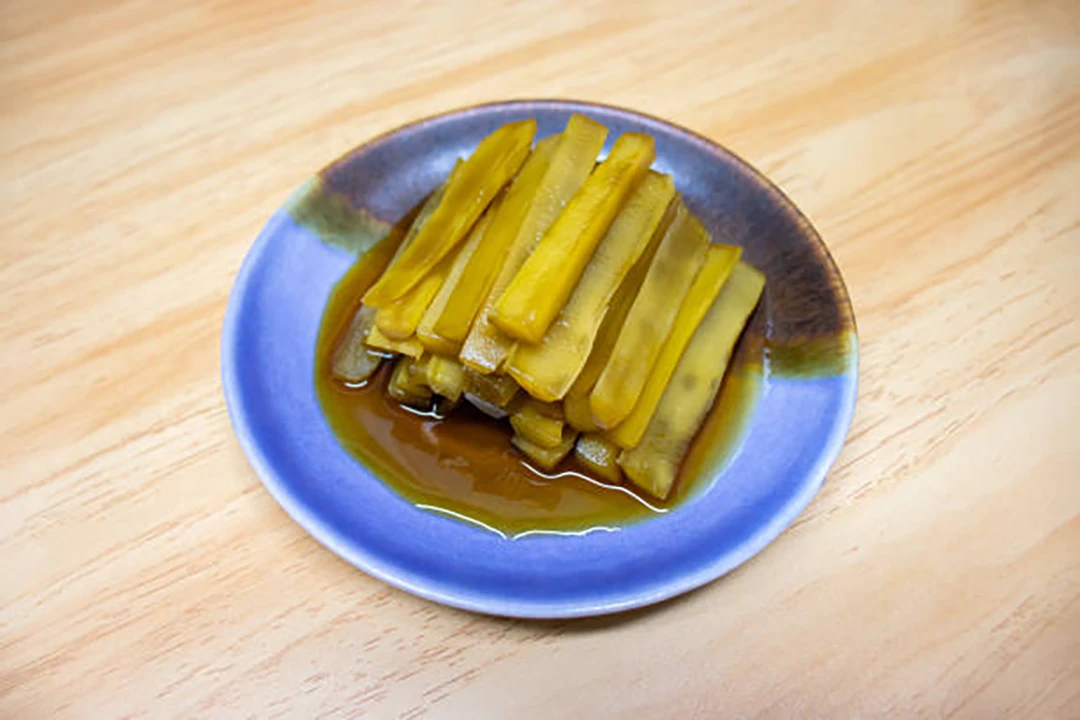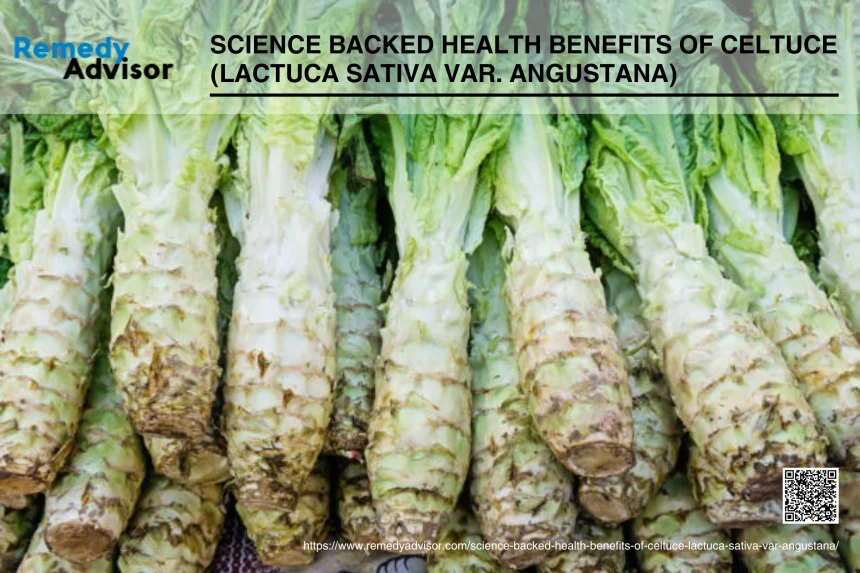Celtuce (Lactuca sativa var. angustana), often referred to as stem lettuce or asparagus lettuce, is a unique and nutritious vegetable that has been gaining attention for its impressive health benefits. Rich in vitamins, minerals, and antioxidants, celtuce offers a range of science-backed advantages that can enhance overall well-being. From promoting digestive health to supporting heart function, this versatile vegetable is a valuable addition to any diet. In this article, we will explore the compelling research and evidence behind the health benefits of celtuce, shedding light on why it deserves a spot on your plate.
What is Celtuce ?
Lactuca sativa var. angustana is a variety of lettuce that is distinct from the more commonly known leafy and head varieties. This variety is particularly noted for its edible stem, which is consumed as a vegetable. Research has shown that it contains a rich array of chemical compounds, including sesquiterpene lactones, phenolic compounds, and various terpenoids. For instance, studies have isolated numerous sesquiterpene lactones and phenolic compounds from its roots and leaves, highlighting its potential medicinal properties. Additionally, the plant has been found to possess significant antioxidant activities, which are attributed to its diverse chemical constituents such as flavonoids and caffeic acid derivatives. The unique chemical profile of Lactuca sativa var. angustana not only underscores its value as a nutritious vegetable but also suggests potential applications in traditional medicine and pharmacology.
Nutritional Profile of Celtuce
Celtuce is a nutritious vegetable with a unique nutritional profile. This low-calorie vegetable contains just 18 calories per 100 grams, making it an excellent choice for those watching their calorie intake. Celtuce is rich in various essential nutrients, including vitamins, minerals, and antioxidants, which contribute to its health-promoting properties.
Detailed breakdown of macronutrients (carbohydrates, proteins, fats)
Celtuce has a balanced macronutrient composition, with carbohydrates being the primary macronutrient. Per 100 grams, celtuce contains 3.65 grams of carbohydrates, including 1.7 grams of dietary fiber. The protein content is relatively low at 0.85 grams per 100 grams, while the fat content is minimal at 0.3 grams. This macronutrient profile makes celtuce a suitable option for those following low-fat or low-calorie diets while still providing some fiber for digestive health.
Vitamins: A, C, K, and B-complex
Celtuce is an excellent source of several essential vitamins. It is particularly rich in vitamin A, providing 3,500 IU or 117% of the daily required levels per 100 grams. Vitamin C content is also significant, with 100 grams of celtuce containing 19.5 mg or 22% of the daily value. While specific data on vitamin K content was not provided, celtuce is known to contain this vitamin. B-complex vitamins are also present in celtuce, including thiamine (B1), riboflavin (B2), niacin (B3), pantothenic acid (B5), vitamin B6, and folate (B9).
Minerals: Potassium, calcium, magnesium, iron
Celtuce is a good source of various minerals essential for bodily functions. It contains 330 mg of potassium per 100 grams, which is 11% of the daily value. Calcium and magnesium are present in moderate amounts, with 39 mg (3% DV) and 28 mg (7% DV) per 100 grams, respectively. Iron content is relatively low at 0.55 mg (3% DV) per 100 grams. Additionally, celtuce contains small amounts of phosphorus, sodium, and zinc.
Phytochemicals and antioxidants
While specific data on phytochemicals and antioxidants in celtuce was not provided in the search results, it is known that this vegetable contains various plant compounds that contribute to its health benefits. As a member of the lettuce family, celtuce likely contains antioxidants such as flavonoids and phenolic compounds. These phytochemicals play a role in protecting the body against oxidative stress and may offer potential health benefits, including protection from certain cancers and promoting overall well-being.
Varieties of Celtuce
Celtuce, also known as stem lettuce, celery lettuce, or Chinese lettuce, comes in several varieties, each with unique characteristics that cater to different growing conditions and culinary uses. Here are some notable varieties:

- Wo Sun (WōSŭn)
Wo Sun, also known as Wo-ju or Wo-chu, is one of the most popular varieties in China. It is valued for its thick, crispy central stalk and mild flavor, which is often compared to asparagus or cucumber when cooked. This variety is particularly suited for stir-frying, soups, and pickling.
- Narrow-Leaved Celtuce
The narrow-leaved variety is distinguished by its slender leaves and robust stem. It is easy to grow and matures in about 90 days. This variety is ideal for both raw and cooked applications, with the leaves often used in salads and the stems in stir-fries.
- Spring Tower
Specifically formulated for North American growers, the Spring Tower variety is known for its adaptability to different climates and its robust growth. It is typically harvested before the buds form to ensure the best flavor and texture. This variety is versatile and can be used in various culinary applications, from raw salads to cooked dishes.
- Standard Celtuce
This variety is often grown in cooler climates and is known for its thick, fleshy stems that can be eaten raw or cooked. The leaves can also be used, although they are generally less palatable than the stems. This variety is commonly used in Asian cuisine, particularly in China, where it is a staple in many dishes.
- Asparagus Lettuce
Asparagus lettuce is another name for celtuce and refers to varieties that have a flavor and texture reminiscent of asparagus. These varieties are often used in similar culinary applications, such as stir-frying and steaming. They are also known for their high nutritional value, providing essential vitamins and minerals.
Science backed health benefits of Celtuce
Celtuce is a nutritional powerhouse that offers a range of science-backed health benefits. This unique vegetable, which is native to China, is gaining popularity worldwide due to its rich nutrient profile and versatile culinary uses. Packed with essential vitamins, minerals, and antioxidants, celtuce can help boost your immune system, support heart health, and aid in digestion. Its high fiber content promotes a feeling of fullness, making it an excellent choice for weight management. Additionally, celtuce contains compounds like lutein, which have anti-inflammatory and antioxidant properties, potentially reducing the risk of chronic diseases. Whether you enjoy it raw in salads or cooked in stir-fries, incorporating celtuce into your diet can contribute to overall health and well-being.

1. Rich in Antioxidants
Celtuce, like other lettuce varieties, is likely to be rich in antioxidants. Studies on red and green lettuce varieties have shown significant antioxidant content, including phenolics, flavonoids, and vitamin C. These antioxidants play a crucial role in neutralizing harmful free radicals in the body, potentially reducing oxidative stress and lowering the risk of chronic diseases.
2. Vitamin C Content
Lettuce varieties have been found to contain varying amounts of vitamin C, an important antioxidant. While the exact content in celtuce may vary, studies on other lettuce types have reported vitamin C levels ranging from 3.50 to 9.60 mg per 100g of fresh lettuce. Vitamin C is essential for immune function, collagen synthesis, and acts as a powerful antioxidant.
3. Potential Neuroprotective Effects
The antioxidants present in lettuce varieties may offer neuroprotective benefits. Research has shown that oxidative stress plays a significant role in neurodegenerative disorders, and antioxidants can help mitigate this damage. While not specific to celtuce, these findings suggest potential benefits for brain health.
4. Nutrient Density
Like other lettuce varieties, celtuce is likely to be low in calories but rich in nutrients. Lettuce is known to contain various minerals and vitamins that are important for overall health. This makes it a nutritious addition to a balanced diet.
5. Potential Stress Resistance

Studies on lettuce have shown that certain environmental stressors, such as water deficit or UV-B radiation, can actually increase the plant’s antioxidant content. This suggests that celtuce grown under controlled stress conditions might have enhanced antioxidant properties, potentially offering greater health benefits.
6. Possible Anti-inflammatory Properties
While not specifically studied in celtuce, other lettuce varieties have shown potential anti-inflammatory properties due to their antioxidant content. This could contribute to overall health and potentially help in managing inflammatory conditions.
How to Incorporate Celtuce into Your Diet
Incorporating celtuce into your diet can be a delightful way to add variety and nutrition to your meals. This versatile vegetable can be used in both raw and cooked preparations, offering a mild, slightly nutty flavor with a crisp texture. To get started, look for fresh celtuce at farmers’ markets or Asian grocery stores. When selecting, choose stems that are firm and leaves that are crisp and vibrant green. Before using, wash the celtuce thoroughly and trim off any discolored parts. The stem can be peeled to remove any tough outer layers, while the leaves can be used similarly to other lettuce varieties.
Fresh salads
Celtuce makes an excellent addition to fresh salads, bringing a unique crunch and subtle flavor. To use celtuce in salads, thinly slice or julienne the peeled stem and tear the leaves into bite-sized pieces. Combine with other crisp vegetables like cucumbers, bell peppers, and carrots for a refreshing mix of textures. The mild flavor of celtuce pairs well with both creamy dressings and light vinaigrettes. For added nutrition and flavor, consider tossing in some nuts, seeds, or crumbled cheese. A simple salad of celtuce, cherry tomatoes, and a lemon-olive oil dressing can be a quick and healthy side dish or light meal.
Stir-fries
Celtuce is an excellent vegetable for stir-fries, as it retains its crispness even when cooked briefly at high heat. To prepare celtuce for a stir-fry, cut the peeled stem into thin diagonal slices or matchsticks. The leaves can be roughly chopped and added towards the end of cooking. Heat a wok or large skillet over high heat, add oil, and quickly stir-fry the celtuce stem with other vegetables like bell peppers, mushrooms, and snap peas. Season with soy sauce, garlic, and ginger for a classic Asian flavor profile. Add the chopped leaves in the last minute of cooking to wilt them slightly. Celtuce stir-fry can be served over rice or noodles for a complete meal.
Smoothies
While less common, celtuce can be an interesting addition to green smoothies, providing a mild flavor and boosting the nutrient content. To use celtuce in smoothies, focus on the leaves rather than the stem. Wash the leaves thoroughly and add them to your blender along with other ingredients like banana, apple, or pear for sweetness, and a liquid base such as almond milk or coconut water. The mild flavor of celtuce leaves allows them to blend well with both fruit-based and vegetable-forward smoothies. For added nutrition, consider including a handful of spinach or kale along with the celtuce leaves. Experiment with different combinations to find your perfect celtuce smoothie recipe.
Soups
Celtuce can be a wonderful ingredient in soups, adding both flavor and texture. For a simple celtuce soup, sauté diced onions and garlic in a pot, then add sliced celtuce stems and cook until slightly softened. Pour in vegetable or chicken broth and simmer until the celtuce is tender. Blend the soup until smooth, then stir in some chopped celtuce leaves and cook for an additional minute. Season with salt, pepper, and a splash of lemon juice to taste. For a heartier soup, consider adding celtuce to miso soup or a vegetable-based broth with other Asian ingredients like shiitake mushrooms and tofu. The mild flavor of celtuce complements a wide range of soup styles, from creamy to clear broths.

Side effects of consuming Celtuce
Here are individual paragraphs on potential side effects of consuming celtuce, based on available information about lettuce allergies and related conditions:
Allergic Reactions
Consuming celtuce may cause allergic reactions in some individuals, similar to other types of lettuce. Lettuce allergy, although uncommon, can be attributed to lipid transfer protein (LTP) sensitization. Symptoms of lettuce allergy can range from mild to severe and may include abdominal discomfort, itching, urticaria (hives), facial flushing, and even anaphylaxis in severe cases. Individuals with known LTP sensitivities or allergies to related foods like peaches, apples, and certain pollens should exercise caution when consuming celtuce.
Cross-Reactivity with Other Allergens
Celtuce may also cause cross-reactivity with other allergens, particularly in individuals sensitized to LTP. This means that people who are allergic to other LTP-containing foods, such as peaches and apples, or certain pollens, may also react to celtuce. Cross-reactivity can lead to a wide range of symptoms, from mild oral allergy syndrome to severe systemic reactions. It is important for individuals with known LTP-related allergies to be aware of this potential risk when trying celtuce.
Respiratory Allergies
In rare cases, handling or consuming celtuce may trigger respiratory allergies, especially in individuals who are frequently exposed to lettuce, such as farmers or food handlers. Symptoms of respiratory allergies can include sneezing, coughing, wheezing, and shortness of breath. These reactions are typically due to inhaling airborne particles or coming into direct contact with the lettuce. Proper handling and protective measures can help mitigate this risk.
Digestive Issues
While not commonly reported, some individuals may experience digestive issues after consuming celtuce, particularly if they have a sensitivity to certain compounds found in lettuce. Symptoms can include bloating, gas, and stomach cramps. These digestive issues are generally mild and can often be managed by adjusting the portion size or preparation method of celtuce. If symptoms persist, it may be advisable to consult a healthcare professional.
Potential for Severe Reactions
In some cases, consuming celtuce can lead to severe allergic reactions, including anaphylaxis. This is more likely in individuals with a history of severe food allergies or those sensitized to LTP. Anaphylaxis is a life-threatening condition that requires immediate medical attention and is characterized by symptoms such as difficulty breathing, swelling of the throat, rapid drop in blood pressure, and loss of consciousness. People with known severe allergies should carry an epinephrine auto-injector and be cautious when trying new foods like celtuce.
Conclusion
In conclusion, celtuce is a unique and nutritious vegetable that offers a range of health benefits due to its rich nutrient profile and versatile culinary applications. With its low calorie content, high vitamin and mineral content, and potential antioxidant properties, celtuce can be a valuable addition to a balanced diet. It comes in several varieties, each with distinct characteristics suitable for different growing conditions and culinary uses. Celtuce can be easily incorporated into various dishes, from fresh salads and stir-fries to smoothies and soups, making it a versatile ingredient in the kitchen. However, as with any food, some individuals may experience allergic reactions or digestive issues, particularly those with sensitivities to lipid transfer proteins or related allergens. Overall, for most people, celtuce represents a nutritious and flavorful option that can contribute to a healthy and diverse diet.
ADDITIONAL RESOURCES
Here are some US organizations involved in vegetable research, along with their descriptions and URLs:
1. USDA Agricultural Research Service (ARS) – U.S. Vegetable Laboratory
This laboratory in Charleston, SC, conducts research to solve regional and national problems in vegetable crop production and protection. It focuses on improving genetic populations of vegetable crops with disease and pest resistance, and developing integrated management systems.
2. USDA Agricultural Research Service (ARS) – Genetic Improvement for Fruits & Vegetables Laboratory
Located in Beltsville, MD, this laboratory focuses on genetic improvement of fruits and vegetables, including disease resistance and quality enhancement. It utilizes genomic approaches and traditional breeding techniques.
3. National Agricultural Library (NAL)
The NAL provides extensive resources on seeds and plants, plant breeding, and plant diseases. It houses genetic material from over 1.1 million plants and maintains a vast collection of nursery and seed trade catalogs.
4. Union of Concerned Scientists (UCS)
UCS conducts research and advocates for sustainable and healthy food systems, including trends in vegetable production, consumer demand, and the impacts of climate change on agriculture.
Recommendations for books on Celtuce
Here are some recommended books on the research of Celtuce:
This book explores the efficient extraction of phenolic compounds from celtuce leaves using green solvents. It provides detailed research on process optimization and the extraction mechanism.
2. “Culturally Informed, Participatory Breeding of Celtuce“
This resource documents the SCOPE research team’s project at UC Davis, focusing on breeding new cultivars of celtuce using participatory methods. It includes insights into cultural and culinary significance.
This platform offers access to a wide range of open-access books, including those related to agricultural research and plant sciences. You can find comprehensive studies and research articles on various topics, including celtuce.
FAQS
- What is celtuce and how is it related to other leafy greens?
Celtuce is a cultivar of lettuce also known as stem lettuce, celery lettuce, or asparagus lettuce. It’s part of the same family as other leafy greens and likely shares some of their nutritional properties.
- What are the main nutrients found in celtuce?
While specific studies on celtuce are limited, as a leafy green vegetable, it likely contains vitamins A, C, K, and various B vitamins, as well as minerals like potassium, calcium, and iron. It’s also probably low in calories and high in fiber.
- Can celtuce contribute to heart health?
Like other leafy greens, celtuce may contribute to heart health. Leafy vegetables are generally rich in potassium and fiber, which can help maintain healthy blood pressure and cholesterol levels.
- Does celtuce have antioxidant properties?
As a green vegetable, celtuce likely contains antioxidants. Vegetables are known for their antioxidant properties, which help protect cells from damage caused by free radicals.
- Can including celtuce in the diet help with weight management?
Celtuce, being a low-calorie, high-fiber vegetable, could potentially aid in weight management when included as part of a balanced diet. Fiber-rich foods can help promote feelings of fullness and support healthy digestion.
- Is celtuce beneficial for digestive health?
The fiber content in celtuce may contribute to digestive health. Dietary fiber is known to support regular bowel movements and promote a healthy gut microbiome.
- Can celtuce consumption support bone health?
If celtuce is rich in vitamin K, as many leafy greens are, it could potentially support bone health. Vitamin K plays a crucial role in bone metabolism and calcium absorption.
- Does celtuce have anti-inflammatory properties?
Many leafy green vegetables have anti-inflammatory properties due to their antioxidant content. While specific studies on celtuce are lacking, it may share these beneficial properties with other leafy greens.
- Can celtuce be part of a diet to prevent chronic diseases?
A diet rich in vegetables, including leafy greens like celtuce, is associated with a reduced risk of chronic diseases such as cardiovascular disease and certain cancers.
- How does celtuce compare nutritionally to other leafy greens?
Without specific studies on celtuce, it’s difficult to make direct comparisons. However, as a variety of lettuce, it likely shares many nutritional similarities with other leafy greens, providing a range of vitamins, minerals, and beneficial plant compounds.







